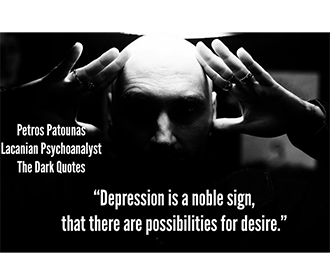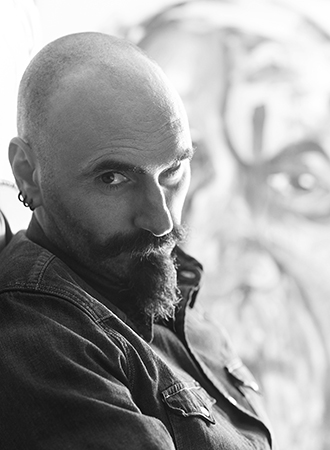 Symptoms treated by Psychoanalysis: Life.
Symptoms treated by Psychoanalysis: Life.
Discontents- that is a symptom, which makes a subject bear an incomparable weight, in one way or another. Unique individuals have unique ways of discontent although the outcome- filtered in the cultural discourse- may appear the same in the violent forms of grouping, turning what ought to be private into something indiscriminate out of context with one’s personal experience as if the subject itself were the symptom to a brilliant theory of an illness. In Lacanian orientation each voice is inimitable, and each symptom is a subject, an outcome of the body’s exposure to language beyond the general formulations of cause and effect- this is the affect of a cause, which, in time, has shaped the body into a discursive one: in fact, not one but another one.
What is the Oedipus myth, if not the structuring of the question “What does it mean to be a human?” a question that outshines the illuminations of both biology and cognition- in fact, and, to be defined: it is a different biology: for biology means the word of life; if it is more apposite, life speaks. Although the word analysis relates to destruction, which is, breaking down into the smallest agencies, it is apropos to describe it as creation, a formation, one that Lacan utter as the direction for the formation of analysts as well, not in mass production but as one by one. In this manner each one’s symptom exists- beyond the statistical silence of individuality, but one by one, dissimilar.
The only certainty being one’s anxieties, manifested through a number of symptoms, only to be categorized into a group of syndromes and such we tend to become: yes, if this is the declaration of a manifesto equal to the ethical guiding principles of a slave. Subjects’ symptoms are the results of a discourse that has marked the entrance of their bodies within the social discourse, and the rebellion towards the demand of subjection, not subjectivity, is the topology of the indication of the symptom, which is, faithfully to the steps of the act, the instant of the subject’s next performance. The entrance into analysis, or, better stated, the crossing towards this path happens not because of the violence of the symptom but because of the symptom’s malfunction, or, if it is favored, the subtraction of enjoyment from the indication of agony, with gratification- one it static: panic attacks, anorexia, boredom, repetition of failed relationships and incidents- no, these do not need cognition because it is their cognition that brings about their failure, doomed into a system of mastery between ideal goal and disillusionment.
We have rushed too much, so much that we have forgotten that speech, as much as in the myth of Oedipus, has been the marking and seminal reference to one’s destiny, written yes but not ours and certainly not the only form of writing- for, when analysand read they actually sculpt: a novel truth. The hastening towards an ideal led to the loss of a place, not a place to bring to a standstill, but, on the contrary, one from where we choose our departures. When a subject reaches that elastic point of departure, psychoanalysis is, does not become, only a moment. No more than an act.


Your proposition: ‘The letter is without a father and never repressed.’Lacan: ‘it’s only the signifier that is repressed.’ The letter is therefore not a signifier. (I am not saying this is correct or that we should hold to this. I am only following the logic.)this leaves us with two elements that could represent the letter, namely the (a) and an affect. But one could already count the object as affect, as affect of enjoyment. Freud had a name for affect: Triebregung or drive impulse, drive-motion (motion is being used in your text above.)The affect could never be repressed (Freud, ch III, ‘The Ucs’, the metapsychology paper, 1915)It could be displaced and connect to another signifier. Freud called this a false connection in the last decade of the 19thC, I forget where. The Triebregung is not repressed but disguised by displacement. Freud only thought of the drive as repressed and unconscious as long as he defined it as a signifier sitting somewhere on the fence, between psyche and soma. He made overwhelming use of the term drive-impule (motion)which allows for displacement. The fact that it is not repressed means that the subject experiences the affect of jouissance constantly. Apologies for not writing this too clearly, but you brought too many things into my head. Richard K
The circle that shapes the subject’s periphery
The circle in Euclidean geometry is the set of all points in a plane, that are at a given distance from a given point, the centre. The distance between any of the points and the centre is called the radius. Following Petros’ reference to the circle “that which is repeated and shapes the subject’s periphery” in relation with the symptom, I would add that the center of the circle, as in the geometrical circle, does not exist, but it is around that which the circle is constituted: it ex-ists. That would lead me to Lacan’s metaphor of the onion: one can peel away all the alienating layers of identity, with tears if need be, but after the last layer there is nothing left (Lacan 1991 [1953-1954])*. This was said in a way to describe that there is no authentic personality under these alienating imaginary built layers, but in my opinion there is something missing from there, the only thing that is authentic: the circle’s center, the drive. I would follow Freud on that, describing the symptom as the grain of sand around which an oyster forms its pearl (Freud 1978 [1905e], p.83)* the drive around which signifiers are built.
Returning to Euclidean geometry, the periphery of this circle, the periphery of subject’s symptom, is given by an equation in relation to the radius from this drive centre:
Periphery = 2 x π x Radius
So, if every term is multiplied by “2” that means that the final result, the periphery, can be divided by “2”: the result has a binary dimension.
The interesting thing about the other two terms, is that although π is considered a constant, a fixed value, and the Radius can have a variable value (the bigger it is, the bigger the periphery), in fact the term that cannot be described is the constant one: the π .
π in mathematics is an irrational number, that is a number that cannot be expressed as ratio of two integers, cannot be represented as a simple fraction, cannot be represented as terminating or repeating decimal. In simple words, if we try to represent π with its complete arithmetic value, this value has uncountable number of digits that have no repetition pattern. It is a series of digits that “does not cease to write itself”, so the π as letter, “does not cease not to write itself”, it belongs to the real. Greeks described irrational numbers as “ά-λογος”, translated as “inexpressible”, or, closer to the original meaning, “speech-less” or “without reason”. In our description, π could represent an S1, the Name-of-the-Father, the π as “Πατέρας” without an “Other of the Other” or the letter that “is without a father” as Petros mentions.
The place left for the value of the Radius, that is variable or interchangeable, is the S2 signifier: if attached to the π as S1 can describe the periphery of the circle.
Petros also mentions “the Lernean hydra of the signifier” and after that “the symptom’s elevation on its square root”. I would say that the cut head of hydra of signifier would give a signifier’s elevation on its square root, another equation related to the geometrical circle, describing its area:
Area = π x Square Radius
the area of subject’s symptom.
Angelos
* I am not sure about the references – I haven’t read them from the originals
The geometry of the subject is constantly changing. Sometimes it is Euclidean, sometimes Riemannian, sometimes Lobachevskian, etc… So sometimes parallel straight lines never meet, and sometimes they do meet. So the subject is a bit of an enigma, as in the Enigma machine. If you do not know the initial conditions (i.e. Das Ding) the best you can hope for is to fumble around, like a drunk (Cf. Dawkins concept of the drunk walk) but somehow you get there. Like a Letter. Which means that the Letter is nachtraglich. 🙂
Pi is like feminine jouissance, it is incommensurable 🙂
Feminine jouissance is a direction of the ethic of the geometry of kinesis itself.